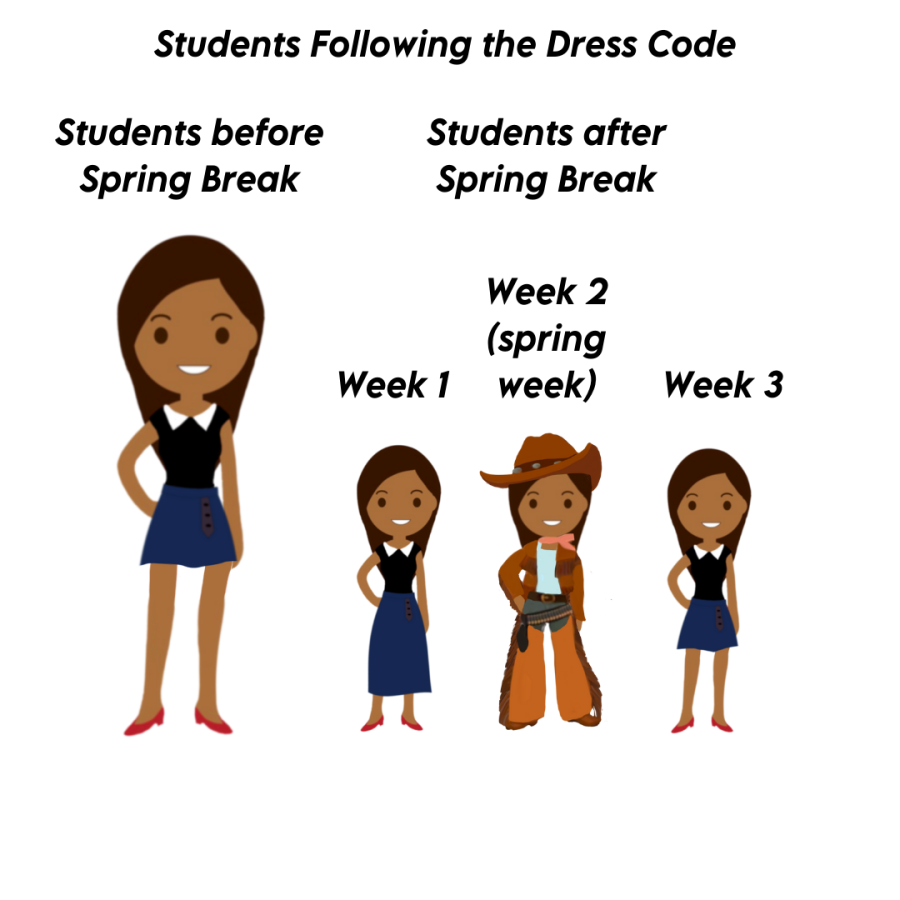Dress code crackdown
Business casual – what does it mean?
May 10, 2022
It’s the week before Spring Break and students are fluttering with excitement. A week off of school. The first trip to a foreign country after the first outbreak of COVID. The day before students leave we are warned: dress code crackdown when school resumes session.
Many seniors know that the dress code evolved several times since the 2018-2019 school year. Starting with oxford collared shirts and ties to polos and shorts to business casual, student prescribed dress regulations have been altered as the years go on.
Senior Shania Espada vividly remembers the days of “Polos on Wednesday and no platform shoes over two inches.”
The business casual dress code is a lighter, more casual interpretation of previous dress codes. Within the business causal parameters, students can wear blouses, button downs, work- appropriate pants, skirts, and ties are optional.
Dean Denmark described the origin of business casual, “We wanted to make it [dress code] not as strict and not as detailed. Now, it’s a challenge because it’s not detailed really at all. And certainly a student’s definition of business casual and mine would be different.”
Many girls began wearing flared leggings and students neglected to wear regulation shirts under their sweat jackets. Denmark described on behalf of both boys and girls, “wearing a sweatshirt without a shirt is common.”
Denmark explained the origin of the dress code crackdown, “Over time, a little bit adds to a little bit and we end up in a spot where we’re looking pretty sloppy. And so it seemed right, especially since spring tends to be a time when stuff gets even more sloppy.”
The dean team came to realize that it is hard to police the dress of over 800 students. They also understand that it is hard for teachers to dress code students without ruining the relationship with the student.
To mitigate awkward student-teacher interactions and promote proper dress, the deans came up with a policy where teachers can discreetly email the deans about any dress code infractions.
“I think that some teachers want anonymity,” Denmark explained.
While the deans did receive an influx of emails following Spring Break, the dress down themes of Spring Week did hinder enforcement of dress code. When asked for exact numbers on demerits given after the institution of the crackdown, the deans declined to comment. However, they did relay a breakdown of demerit percents.
Denmark relayed, “The week after break 17% of all demerits were for dress code. The two weeks after Spring week 22% of all demerits were for dress code—so either the students dress improved or there was less reporting and/or enforcement.”
As of press time, as I walk through my days I notice more and more students are slipping back into old habits. On Tuesday 4/12, I noticed three girls in yoga pants on my walk between Bolles Hall and Schultz. That same day, I noticed tank top blouses and a lack of belts.
However on the positive side, I notice more diversity in student fashion as the loose nature of business casual allows for greater freedom in the types of clothes that can be worn and stores students can buy from.
While the dress code can be vague, Denmark encourages students to always consult with the deans on areas of confusion. “I’d love for kids to come and ask me about an item of clothing,” Denmark explained, “Or, if they have an idea about something and they’re not sure they could send me a picture.”







